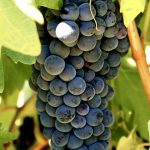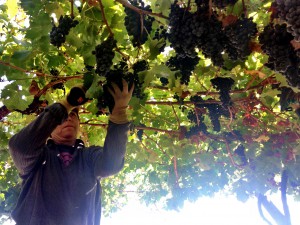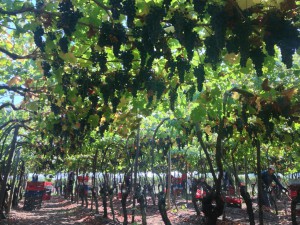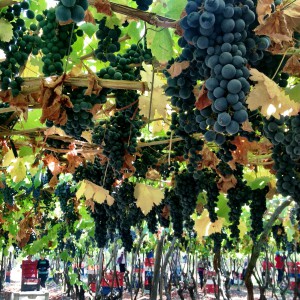Wine Grape Spotlight – Malbec
Malbec is a grape variety with a deep, inky color, producing dry red wines that boast robust tannins and a long, smooth finish.
Where is Malbec from?
Malbec was almost exclusively grown in France, where it played a primary role as one of the main Bordeaux grapes. The climate and pests in France did not allow for Malbec to perform to its utmost potential. Struggling to thrive, growers saw it as weak, finicky, and susceptible to disease as well as rot. It is mainly associated with Argentina and Chile now because it thrives there. It took well to the climate, excelling in the high elevation and heat, making it one of the most widely planted grapes. In the United States, you can find the majority of wine grape plantings in California, yet Malbec only makes up for 0.5% of those plantings.
Malbec Characteristics
This grape can yield a wide range of fruit aromas that vary widely depending on the climate they are grown in. Cooler climates like France and Washington state yield black cherry, raspberry, and plum aromas. For warmer climates like Chile, you’ll get more blackberry, blueberry, plum, and black cherry. They’re juicy and jammy, with notes of vanilla, tobacco, dark chocolate, and oak. They have medium acid and moderate levels of tannins. Chilean Malbec’s boast with red fruit flavors like cherry, raspberry and have floral and slight earthy notes.
Can I make my own?
Musto Wine Grape Company is here to help you make the wine of your dreams! The Spring Chilean winemaking season starts in late April, early May. Secure your Malbec and give us a call at (877) 812-1137 to speak with one of our Musto Crush Crew members. We can get you set up with everything you need and provide customer support along the way to ensure your success!
How to Make Chilean Malbec Wine at Home
Making a New World Classic – Chilean Malbec
Chilean and Argentinian Malbec has become famous around the world for its consistently high quality and intense fruit flavors. Musto Wine Grape carries either fresh Chilean Malbec grapes or juice so that you can make wine at home. Chilean Malbec was the first wine that I made at the professional level, and it will always have a special place in my heart and at my dinner table. Here is my recipe for making a classic, fruity, Chilean Malbec at home.
- Crush Malbec grapes into a sanitized bin or tub. (Each 18lb crate will make 1.25 gals of finished wine).
- Apply 50ppm of Potassium Metabisulfite and stir well. Allow to sit for 8-12 hours.
- Apply .5ml of Color Pro Pectic enzyme per box diluted into a 10% solution with water to the must and stir. Allow to sit for another 8-12 hours.
- Mix Booster Rouge, FT Rouge, and Opti-Red, with spring water until it is the consistency of pancake batter and pour over top of crushed grapes. Mix in well.
- Add rehydrate CSM yeast (1g/gal) with Go Ferm rehydration nutrient and warm water. Allow to sit for 15 minutes and pour over top of crushed grapes.
- Punch down grapes 3 times per day throughout the duration of fermentation and monitor temperature and Brix levels daily. Use a hydrometer to test sugar content in a strained juice sample. Make sure the temperature does not exceed 85F.
- One day after adding the yeast, add Fermaid O, mixed with spring water in to the pancake batter style slurry. Dump into grapes during a punch down.
- After the depletion of 1/3 of the Brix (when the Brix level is between 16-11), add Fermaid O that is mixed with spring water into the pancake batter style slurry. Dump into to grapes at a punch down.
- Add Malo-lactic bacteria the same day as the Fermaid K. If you are using liquid cultures, just pour over the grape must and mix. If you use the dry cultures, rehydrate them in warm spring water according to their specific directions, utilizing any rehydration nutrients recommended.
- When the Brix have dropped below zero, press the wine into a sanitized tank, carboy, or demijohn. Make sure the vessel is topped up all the way to the top of the neck and sealed properly with a bung and airlock.
- Rack after 48 hours and then again in a week. Allow MLF to complete before adding sulfites.
- Allow the wine to age and rack it every 2 months and add sulfites when racking.
Recipe by the Winemakers at Musto Wine Grape
Interested in making your own wine? Musto Wine Grape Company is here to help! Musto’s New England’s largest supplier for home winemaking products and services. Visit juicegrape.com or give us a call at (877) 812 – 1137 to learn more.
2017 Chilean Wine Harvest Update
2017 Chilean Harvest:
2017 was a fantastic growing season up until the other day. As many of you might have heard on the news massive fires broke out in Chile. The fires have been a devastating blow to the Chilean people. However, The Curico Valley and the Southern regions of Colchagua Valleys were thankfully not affected. Unfortunately other Chilean wine growing regions such as the Maipo Valley were greatly affected by the fires and might not be able to produce vintages this year. We encourage everyone to donate to the Red Cross to aid in the relief of these fires.
The growing season for the Curico and Colchagua Valley’s was a hot and dry one. Expect wines with great character, intense flavors, complexity, and distinction. We should be receiving grapes around the same time as last year, maybe a little earlier for the whites. The first white grapes will be picked at the end of February. Carmenere will be in shorter supply this year as the demand has gone up for this grape, so put your orders in early!
The wines of Chile – along with the winemakers and vineyards that produce them – have had some profound transformations in the past 30 years. Grape growers have successfully determined which varietals thrive in their vineyards, have experimented with unique trellising systems, and explored interesting new areas for planting. The wines now have a head start because of the wonderful grape quality.
Musto Wine Grape Company, LLC. has been importing quality Chilean wine grapes for over 10 years. We have developed long lasting relationships in Chile and are constantly growing and developing the program. The vineyards are located between the Andes Mountains and Pacific Ocean. Therefore, the vines have excellent growing conditions for perfect ripeness and complexity thanks to the ocean breeze and Mediterranean climate.
The Curico Valley has been a wine grape growing region since the 1800’s and is located about 115 miles south of Santiago in the Central Zone of Chile. It is known as the “Heart of the Chilean wine industry”. Curico has the perfect fertile soil and is best known for its micro climates and the ability to grow over 30 different wine grape varieties. Situated along the Guaiquillo River and nestled between mountains on its east and west sides, Curico’s Mediterranean climate and unique topographical features helps to create some of the finest wine grapes in South America.
The climate in the valley is characterized by morning fog and wide day-night temperature fluctuations. Climatic conditions in some parts of the valley favor wines with higher acidity, such as white varieties including Chardonnay, Sauvignon Blanc, Vert and Gris. High quality Cabernet Sauvignon, Syrah, Merlot, and Carménère grapes are sourced from warmer areas of the valley, such as Lontué, particularly when produced from ancient vines.
Terroir: Sandy, clay, decomposed granite, volcanic-alluvial
Grape Varieties Available: Cabernet Sauvignon, Cabernet Franc, Carmenere, Malbec, Merlot, Petite Verdot, Pinot Noir, Syrah, Chardonnay, Pinot Gris, Sauvignon Blanc, Viognier
Juice Varieties Available: Cabernet Sauvignon, Cabernet Franc, Cabernet-Merlot Blend, Carmenere, Malbec, Merlot, Petite Verdot, Pinot Noir, Syrah, Chardonnay, Pinot Gris, Sauvignon Blanc, Viognier, Muscat













Recent Comments